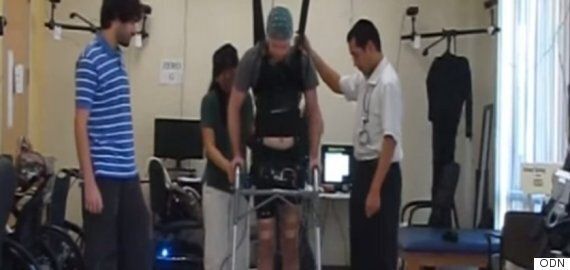A paralysed man has made medical history after he was able to use mind control to walk again.
26-year-old Adam Fritz who lost sensation in both his legs was able to stand up and take a few steps simply by thinking about it, according to a study published in the Journal of Neuroengineering and Rehabilitation.
The breakthrough is owed to a functional electric stimulation (FES) device, which essentially acts as a communicator between Fritz's brain and legs.

During paralysis, the brain is still able to send out signals the body can receive.
In order for both processes to work in conjunction, a team at the University of California, Irvine captured brain activity using an electroencephalogram (EEG) cap.
They then created an algorithm that translated these brain signals into messages the FES device could read.
Before it was attached to Fritz's legs, he practised harnessing the power of his thoughts on avatars.
Speaking about the moment he took his first steps, he told Sky News:
"It was incredible.
SEE ALSO:
- Paralysed Man Feels For The First Time In Ten Years After Receiving Ground-Breaking DARPA Robotic Hand
- 3D Printed Low-cost Robotic Hand For Amputees Wins James Dyson Award
- Bionic Hand Helps With Small Things
- Amputee Successfully Controls Robotic Arms Using Just His Thoughts
- Bionic Hand Breakthrough: Direct Wiring To Nervous System To Restore Touch To Amputees
"When you're first injured, you're sitting in hospital hoping you'll walk again but when it actually happened, it was a dream come true.
"I actually did it and it was something I'll never forget."
The feat however, took a lot of practice. During training, Fritz was able to control the FES device accurately around 70 percent of the time, the New Scientist reports.
Zoran Nenadic who led the team told the New Scientist: “We got this up to about 99 per cent accuracy,”
"When we told him to, he could start walking ...he walked 1.8 metres to a traffic cone, could stop for 30 seconds, and then continue the length of a 3.6 metre course.”
While this is the closest scientists have come to offering paralysed people the chance to walk independently, experts say the research still has a long way to go.
Some of the key elements the study will need to address in the future includes balance and improving the accuracy of the FES device to 100 percent.